Errors of British shipbuilding. The battle cruiser "Invinsible". H. 3
If the weak booking of the battle cruisers was not D. Fisher’s invention, then the use of the “battleship” 305-mm caliber on them should be credited to him, although news of Japanese armored cruisers with twelve-inch guns pushed him to this. And the need to ensure 25-nodal speed resulted from the Admiralty’s assumptions about the presence of armored cruisers with 24 knot speed in other countries, which made 25 nodes for the newest British ships of the same class look reasonable minimum.
The poorly known, almost “rhombic” location of the main-caliber guns, in which firing all eight guns onto one side was impossible, was caused both by the desire to provide strong fire in the bow, the stern and on sharp course corners, which is very important for the cruiser, and the British did not understand features of artillery combat on 60-90 cables, i.e. distances at which the battlecruisers actually fought in the First World War. During the design of Invincibles, the British did not even know how to shoot cables at 25-30 and believed that future naval battles would take place on 30, the maximum is 40 cables, hardly any further. It must be said that the members of the Design Committee were not thrilled by the inability of the new cruisers to use all the artillery for one purpose, but did not find a way, retaining the ship’s lines required to reach 25 units, place them differently - for example, moving the “traversing” towers to extremities.
Having finally decided on the main characteristics of the future battlecruiser - 8 * 305 guns, 25 nodes, and booking "like the" Minotaur "- the British started designing.
Reservation
Strangely enough, but the chief designer "did not obey" the technical task, which is why armor protection, in comparison with the latest armored cruisers of the "Minotaur" type, was significantly improved.
The basis for the protection of "Invincible" and "Minotaur" was 152 mm citadel. Here are just 152-mm armor-belt "Minotaur" covered only the engine and boiler rooms (and at the same time - the artillery shell of the 190-mm guns towers, placed on the sides). In the bow and stern of the armor belt, the same 152 mm traverses closed. Accordingly, the main thing weapons “Minotaur” - 234-mm tower, located outside the citadel, in the extremities, which protected only 102-mm armor in the bow and 76-mm - in the stern. At the same time, at Invincible, the 152-mm armor belt covered all the towers of the main caliber, only the stern slightly “protruded” behind the armor belt, but from its edge to the barbet of the tower 152 mm traverse went, smoothly turning into 178 mm barbet. The front beam has a thickness of 178 mm. Thus, although the vertical booking of the British cruisers' citadels was rather conditional, at least at Invincible it protected all the towers of the main caliber, which was an undoubted advantage. The bow of the battlecruiser received 102 mm armor, but the stern was not armored at all, which is perhaps the only drawback of Invincible compared to the Minotaur. On the other hand, it is obvious that the savings obtained as a result of not protecting the stern (and 76 mm of armor could only cover it up from fragments of heavy projectiles) were used by the British to strengthen the citadel, which looks quite reasonable.
Horizontal protection included two "layers". The armored belts of both cruisers reached by their upper edges to the main deck, which the Minotaur defended as much as 18 mm armor within the citadel and 25 mm outside it. In Invincible, the exact opposite, 25 mm armor and 19 mm were installed over the citadel in the bow, and the food was not completely protected. At the same time, over the cellar areas of the first three towers (except fodder), as well as over the central post, the armored hull thickened to 50 mm - however, it is not clear whether this additional protection was initially, or whether it concerns the state of the ships after the Jutland battle. The author of the article is inclined to believe that 50 mm protection was originally.
The armor (lower) deck of both cruisers was located at the level of the waterline (horizontal part) and had identical thicknesses within the citadel - 38 mm in the horizontal part and 50 mm bevels going to the lower edges of the armor belts. But for Invincible, the same armored form continued into the nose, but for the Minotaur in the nose with bevels of the same thickness, the horizontal part had only 18 mm. In the rear, the bevels and the horizontal part of the Invincible armored deck had increased protection up to 63,5 mm, which, in fact, alone covered the steering devices. In the Minotaur, it is unclear, probably the horizontal part was protected with 38 mm armor, and the bevels either 50 or 38 m, but taking into account the vertical 76 mm armor belt, the food was better protected.
But on the "Invincibles" local booking of cellars was applied - from the side of the boards they received 63,5 mm bulkheads. However, only from the sides - from the shells that pierced the armored deck along the ship hull, these bulkheads did not protect. The British themselves saw in them protection from underwater explosions, i.e. torpedoes, because there was no serious PTZ at the Invincibles.
Thus, to hit the Minotaur or Invincible's engine room or boiler room, the enemy projectile would have to overcome the 152 mm belt and the 50 mm bevel. But in order for the projectile to “reach out” to the artillery cellars of the main caliber of the Invincibles in a battle on parallel courses, it had to penetrate not only the 152 board and 50 mm bevel, but also the additional 63,5 mm protection.
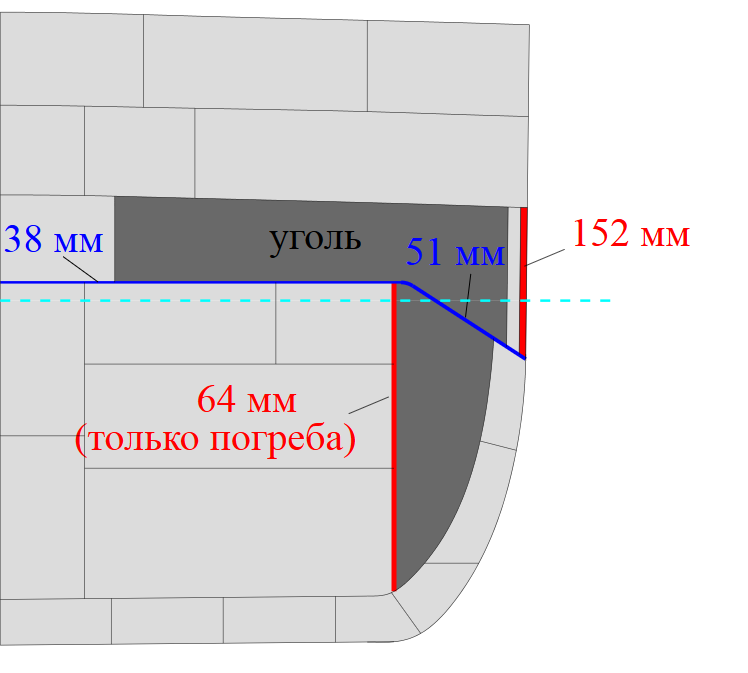
At the same time, the 234-mm cellars of the Minotaur's projectiles and charges were defended with only 102 mm board and 50 m bevel (in the nose) and 76 mm board and 50 mm, or even 38 mm bevel.
But the towers and barbets had a similar vertical protection 178 mm, while the barbety of the specified thickness reached the main deck. The exception here was only a part of the barbet of the Invincible aft tower, not covered by 152 mm by means of a beam - it kept the thickness of 178 mm up to the armored deck). But below the main deck, the barbets lost much in defense. In the interval between the main and armored decks, the 234 mm barbats of the Minotaur towers had 76 mm (bow) and 178-102 mm (stern) and the 190 mm barbets of the towers - 50 mm. At Invincibles, all the barbets between these decks were only 50 mm thick. However, the protection of these parts of the barbets from the fire at the Minotaur and Invincible was quite comparable. In order to hit the flow tube of the nose tower, the projectile had to punch 102 mm onboard armor and 76 mm barbet at the Minotaur, in total - 178 mm of armor, and at Invinsible - 152 mm board or 178 mm traces and, after that , 50 mm barbet, i.e. total protection was 203-228 mm. The aft feed tube was defended by the Minotaur better - 76 mm board and 102-178 barbet, i.e. in aggregate 178-254 and armor, in Invincible - 178 mm or 152 mm traverse + 50 mm barbet, i.e. 178-203 mm.
Interestingly, all the sources of the chorus argue about the perfect insufficiency of the horizontal booking of British battlecruisers. From the source and source, the dialogue of captain Mark Kerr, the commander of the completed Invincible and the main builder Philippe Watts, held in 1909 g, “roams”:
According to Kerr Watts, he replied that he "knows about this danger," but:
All this is in fact true ... and, at the same time, not so, because the same reproach can be addressed to any ship of those times. Invincible had 25 mm horizontal armor on the main deck and 38 mm on armor, total 63 mm, while the Dreadnought horizontal protection consisted of 19 mm main and 44 mm armor decks, i.e. in aggregate, all the same 63 mm. The German Nassau had only one armored deck, in the horizontal part, which had a 55 mm. True, the main deck had an 45 mm reservation, but only over dungeons (and probably around the bow and stern towers of the main caliber) i. was in fact mostly unarmored.
None of these defenses could help against a quality 305-mm projectile. If the 280-305-mm German armor-piercing “suitcase” fell into the 25 mm main deck, he usually overcame it without tearing - at least in most cases in the Jutland battle was exactly that. Naturally, the shell in 19 mm projectile would overcome with even greater ease. After passing inside the citadel, the projectile could detonate, hitting the deck in the 38 mm. As shown by the shelling of "Chesma" by Russian 305-mm armor-piercing shells, arr. 1911 g (470,9 kg), 37,5 mm of armor does not hold such a gap - a rather large hole is formed, and the space reserved is affected by fragments of the broken armored form and the shell itself.
As for the German 55 mm armor, then it is worth remembering the post-war, already Soviet tests of 305-mm and 356-mm shells, which took place in 1920. As it turned out, even 75 mm armor "does not hold" the projectile break if it came into contact with it: it can protect from the impact of a shock wave and fragments of an 305-mm projectile only if it exploded in 1-1,5 meters from the armor plate. Thus, a direct hit on the armored deck of the Nassau also did not bode well for the German ship. It would be a different matter if the shell would first hit the casemate roof - 45 mm armor would most likely cause the detonation of the shell, then the 55 mm armor deck had good chances to hold the fragments. Or at least a significant part of them.
Thus, the only thing that, perhaps, was the horizontal booking of Invincibles - the non-omission of shells in the form. Of course, there was a danger of burning fragments of engine rooms, boiler rooms and, of course, artillery cellars, but the chances of detonation of ammunition or ignition of gunpowder charges were still lower than when the projectile broke in the cellar. But from the penetration and rupture of the projectile inside the barbet booking "Invincibles" did not completely protect.
As we have said, the 25 mm deck did not prevent the penetration of the projectile into the citadel as a whole. But if, entering the citadel, 280-305-mm projectile fell into the British 50 mm barbet, he, of course, easily punched him and exploded inside the feed tube, which was not at all good. In this case, specially arranged valves in the reloading compartment could prevent the penetration of fire and energy of the explosion into the cellars, but the Germans introduced this innovation only as a result of the fighting at Dogger banks, the British did not have it in Jutland either.
Alas, the same could be said about the "Dreadnought". A heavy shell piercing the 19 mm deck hit the 100 mm barbet - with exactly the same result. Yes, the Nassau was not fully protected from such troubles - in the area below the main deck the barbettes of his guns had “spotted” protection with armor thickness from very impressive 200 mm, to completely unintelligible 50 mm (such armor was in places where shells hit was considered unlikely, for example, the back of the barbet facing the middle of the ship).
Thus, one can speak of the weakness of the Invincible barbets between the main and armored deck as the key vulnerability of the project, but how could this be fixed? Unless, having refused to reserve the main deck (or significantly reducing its thickness), make barbets of towers of the main caliber 178 mm thick all the way to the armor deck - but in this case the already weak horizontal armor became quite conditional…. And there were no other stocks. As we said above, when asked about the weakness of the horizontal defense, Philip Watts reminded Kerr of the Admiralty's requirement to protect the ship from the fire from the 45 cable range. But the British 305-mm guns of the battleships of the Nelson type, which were also installed on the Dreadnought and Invincible on the 37 cable, pierced armor equal to their own caliber, i.e. 305 mm. Against this background, 152 mm armor with 50 mm bevel looked after him ... well, let's say, such protection could help on 45 cable unless a miracle and if the projectile gets at a large angle to the armor, and even then it is unlikely. The vertical booking of the Invincibles made it possible to hope for something except the cables on the 70-80, but here the deck became extremely vulnerable.
In general, the following can be said about the defense - strangely enough, the Invincible managed to make a big step forward in comparison with the armored cruisers of all previous projects, but, of course, the defense didn’t meet the requirements of a squadron battle. Virtually all of it, that horizontal, that vertical, was a continuous vulnerability, in which, nevertheless, the weakness of booking barbets between the main and armored decks was particularly highlighted.
In the comments to the previous articles of this cycle, the opinion was repeatedly expressed that the protection of Invincible should be strengthened by increasing the displacement. This is certainly true, but in this matter one cannot ignore a certain inertia of thinking: the dogma that a cruiser cannot be larger than a battleship could not be overcome overnight.
In terms of size, "Invincible" and so was amazing. As we said earlier, the British built their battleships and armored cruisers so that they fit together. The last British armadillos of the Lord Nelson type had a normal displacement within 16 000 T. (16 090 T “Lord Nelson” and 15 925 “Agamemnon”), and the corresponding armored cruisers “Minotaur” - 14 600 T. or 91,25 “17” or XNNX 250. displacement armadillos. Invincible had a design normal displacement in 17 900 t, “Dreadnought is 96,37 25 t, i.e. the battle cruiser was already almost equal with the corresponding battleship (XNUMX%). And besides, it should be remembered that increasing the displacement, taking into account the speed requirement for XNUMX nodes, would require a more powerful power plant, while at Invincible at the time of laying it was the most powerful in the entire Royal Navy.
Artillery.
The main caliber "Invincible" was quite reliable 305-mm / 45 guns Mk X. These guns were developed in 1903 g and 386-kg fired a projectile with an initial speed of 831 m / s. At the time of their appearance, they had an approximate parity with the American 305-mm / 45 Mark 6, created in the same year and firing slightly heavier projectiles (394,6 kg) with a slightly lower initial speed (823 m / s). But the English gun was colossally superior to the newest German 280-mm / 40 SK L / 40 guns, created just a year earlier for the Braunschweig and Deutschland armadillos. France and Russia at that time still used twelve-inch guns, developed at the end of the last century, so that here the advantage of the British artillery system was indisputable. For its time, the 305-mm / 45 Mk X was an excellent gun, the problem was only that this time quickly passed. In the 1906-1910 period, all the leading fleets of the world developed new 305-mm guns, which the British Mk X conceded in all respects: as a result, Invinsible was opposed by German ships armed with 305-mm / 50 SK L / 50, shooting 405,5 - 405,9) kg shells with initial speed 855 m / s.
The range of the main caliber "Invincibles" was not determined by the capabilities of the weapon, but by the maximum angle of elevation for which their installations were designed. It was only 13,5 hail, which ensured the 80,7 cable range, and only in 1915-1916, when the battle cruiser of the battle cruisers was replenished with new projectiles, the firing range reached 93,8 cable. Of course, the vertical angle in 13,5 degrees is extremely small and is a drawback of the Invinsible type battle cruisers, but how can we blame the British, who at the time of the towers' construction assumed that 40-45 cables are a very large distance for a firefight?
Thus, the "Invincibles" were armed with quite modern guns of the main caliber, but by the First World War they were already outdated. And although it was not the designers who were to blame for this, but technical progress, the British sailors had to fight a much better armed enemy.
As for the tower installations, it is not so simple. The same type of Invincible and Inflexible and Indomiteble received the standard for the Royal Navy hydraulic system: all the movement of the towers was provided by hydraulics. But at the "Invincible", as an experiment, it was decided to put all-electric towers. Interestingly, the ship received towers of different designs from two different manufacturers: the bow and stern towers had Vickers machines, and the onboard, also called traversing, Armstrong. As a matter of fact, this alone could no longer be called the merits of the project ...
It must be said that the experiment ended in a deafening failure, but here, again, the manner of presentation of European historians is of interest. Here is how O. Parks writes about this:
It would seem, well, what's wrong with that? We tried the novelty, made sure that the electrician did not demonstrate significant advantages and that the game was not worth the work, and returned to the old, proven solutions. Ordinary working moments ... But a detailed description of the “not so best” electric drives, compiled by A.Y. Fetter:
The ship, of course, was immediately sent for revision of the tower mechanisms, and only five months later, in March, X. NUMX of Invincible re-entered artillery tests. It turned out that firms had corrected the identified defects, but now the mechanisms of horizontal and vertical tool laying were regularly failing. After that, the Invincible towers were examined by Admiralty officials and company representatives, and the examination revealed many shortcomings in the design of electric drives and all this required improvement. The ship returned to repair, but in the summer of the same year, numerous shortcomings again emerged.
O. Parks reports that Invincible entered into service in March 1908 g. But even in summer, only four 1909 gs from its eight main-caliber guns could shoot, and even those that were not at all the rate of fire recorded by them in passport. This situation was intolerable, and in August, 1909 from Invinsible was sent to the Portsmouth shipyard. It was assumed that by the third week of November the tower installations could be “brought to life”, but it soon became clear that the deadlines were too optimistic that the work would be completed only for the new year, but even then the Invincible towers continued to “delight” sailors and developers with new defects . As a result, the ship was able to bring 1910 to the main caliber firing only. Is it necessary to say that they too were a failure?
In March, 1911 G made the last attempt to bring the electrical drives to a working condition. The battlecruiser arrived in Portsmouth for a three-month repair, which Vickers and Armstrong had to pay out of pocket. Alas, after these alterations, nothing worked as it should, and the Admiralty sadly stated:
And this fiasco, this completely incapacitated equipment, O. Parks calls “not so good as to replace the hydraulic system with it” ?! The author of this article once again states: if the domestic historiography of recent decades has developed a manner of "repent of all sins" looking for all sorts of shortcomings of domestic ships (aircraft, tanks, training of troops, abilities of generals, etc. etc.), then Western sources very often circumvent their failures and mistakes, if not in silence, then retouch them, mentioning that even the biggest problems look like minor misunderstandings.
But back to Invincible. So, back in 1911 it became clear that it was impossible to bring the electric towers of the battle cruiser to mind - but only on 20 in March did 1912 decide to install time-tested hydraulic actuators at the Admiralty meeting: it was believed that this work could be done in 6 months, and the cost will be 150 thousand pounds sterling (after it, the cost of building Invincible will overtake Dreadnought) However, it turned out that the “Lady of the Seas” categorically did not have enough ships and Invincible was forced to go to emnoe sea, represent the interests of the UK. With a completely unusable main caliber artillery.
And only in December, 1913 Mr. "Invincible" returned to Portsmouth, and finally got up for such a long-awaited repair, which lasted for six, and eight months. But on the other hand, the battle cruiser got rid of electric drives and got hydraulics familiar to British sailors: alas, the fact that the towers were originally created for electricity played a cruel joke on the ship. Of course, the cruiser finally gained combat effectiveness, the new hydraulic actuators worked, but how? Artillery officer, Lieutenant Commander Invinsible Barry Bingham recalled:
Gushing valves were discovered at the very first firing, which took place after the completion of the Invincible repair. The following firing took place on 25 August 1914 of the year (the war has been almost a month). Junior Lieutenant Stivart, the officer loading the guns in turret A, described hydraulics as follows:
In general, it can be stated that the result of the experiment with the electrician was that the first battlecruiser in the world actually had no efficient artillery for six and a half years of its service! By the way, be it said, the electric drives of the towers were not at all the transcendent apex of human genius - they were used both in the American and Russian fleets. So, for example, towers of battleships of the type “Andrew the First-Called” were completely electrified and there were no problems with their operation.
British shells of the main caliber ... strictly speaking, they are not an advantage or disadvantage of a project of a particular ship, and besides, they are worthy of a separate material, so we will mention their many "merits" in the next, final article of the cycle.
The Invincible mine action artillery was represented by sixteen 102-mm / 40 QF Mk guns. III, firing 11,3 kg (later - 14,1 kg) with a projectile with an initial speed of 722 (701) m / s. For its time, it was a very rational decision. The fact is that in England for a long time the 76-mm guns were considered sufficient to repel the attacks of the destroyers. Even the Dreadnought received exactly 76-mm anti-mine caliber and Invinsible was supposed to get the same guns on the project. But the Russian-Japanese war showed the fallacy of this decision, the British conducted experiments on the destroyer "Skate" in 1906 g and were convinced of this themselves. As a result, much more powerful 102-mm guns were installed already in the process of building on Invincible. At the time of the entry into service of the battlecruiser, it was probably the best caliber for mine artillery. However, closer to World War I, destroyers increased dramatically in size, and 102-mm guns were no longer enough for their reliable defeat. And again, as in the case of the 305-mm main caliber, it is not the developers who are to blame for their obsolescence, but the extraordinary pace of pre-war naval progress.
But if there are no complaints about the caliber and the number of mine action artillery barrels, their placement is rather doubtful. Eight guns were installed in the superstructures, four in the fore and aft, and it looked perfectly reasonable. But the remaining eight guns were located on the roofs of the towers of the main caliber, and it is completely unclear how the British were going to organize the supply of shells there? After all, it is obvious that no one will store several dozen shells in anticipation of a mine attack on the roof of the tower, and if so, it is necessary to organize a very fast delivery of these shells when the need arises.
Power plant
Fully justified all the expectations placed on her. It was expected that the ships would develop 25,5 nodes with 41 000 horsepower, but in fact Invincible developed the 46 500 hp, and its speed was 26,64 node. And this is despite the fact that, judging by the draft in the sources at the time of testing, the ship had a displacement greater than normal, and certainly in no case was not over-light. But the best performance "Invincible" showed, being transferred to the fleet, it was noted the achievement of 28 nodes (which looks a bit dubious, but nonetheless). In any case, at the time of entry into service, Invincible became the fastest cruiser in the world. In addition to power, his power plant was distinguished by reliability and, on the whole, would deserve the highest praise, but ...
The only drawback of the power plant was the mixed heating. The fact is that, unlike the same German ships (later built), the Invinsibles did not have separate oil boilers. The design assumed that the oil would be injected into the coal-fired boilers through nozzles, that is, both the coal and the oil would burn simultaneously in the cruisers. Such a scheme was used on ships of various countries, but the English didn’t work here again. The design of the injection of liquid fuel was very imperfect, demanded great skill from the firemen and was not mastered by the Royal Navy. For example, when trying to burn oil simultaneously with coal in a battle near the Falkland Islands, the formed clubs of thick black smoke interfered with Invinsible’s gunners and other ships' gunners.
As a result, the battle cruisers refused to use oil at all, but what consequences did it have?
The total fuel supply of the Invincible-type battlecruisers of all three ships differed slightly, at the Invincible itself, it consisted of 3 000 tons of coal and 738 tons of oil. At the same time, the cruising range of the cruisers was 6020 - 6 110 miles by a fifteen-node course or 3 050-3 110 miles on 23 nodes. Refusal of oil led to a drop in range to 4 480 - 4 600 miles and 2 270 - 2 340 miles, respectively, which was not a good result for ships that were supposed to protect ocean communications. Armored cruisers of the “Minotaur” type had a range of 8 150 miles, though not fifteen, but only a ten-node course.
To be continued ...
- Andrei from Chelyabinsk
- Errors of British shipbuilding. Linear Cruiser "Invincible"
Errors of British shipbuilding. The battle cruiser "Invinsible". H. 2
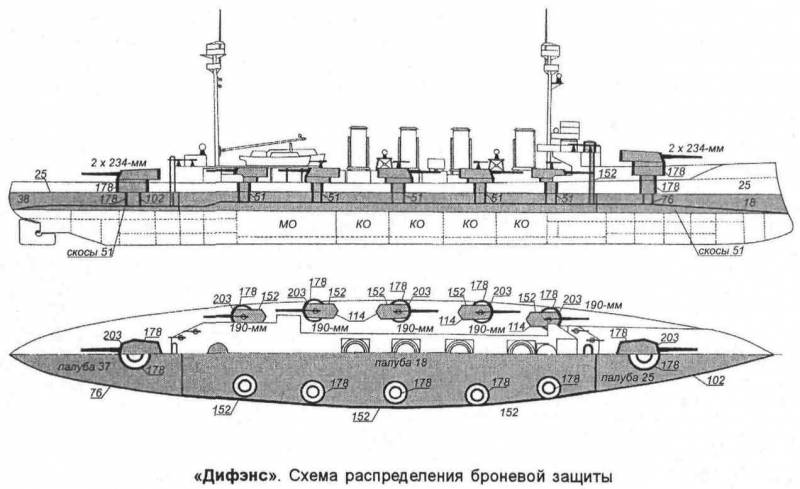
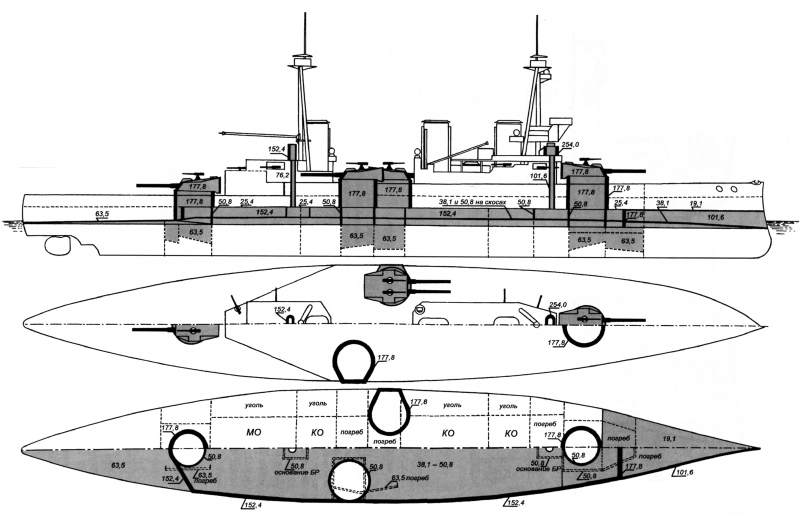
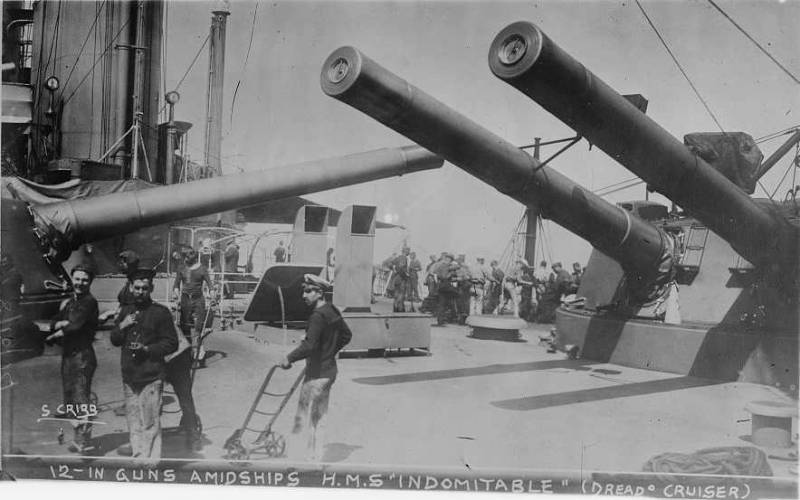
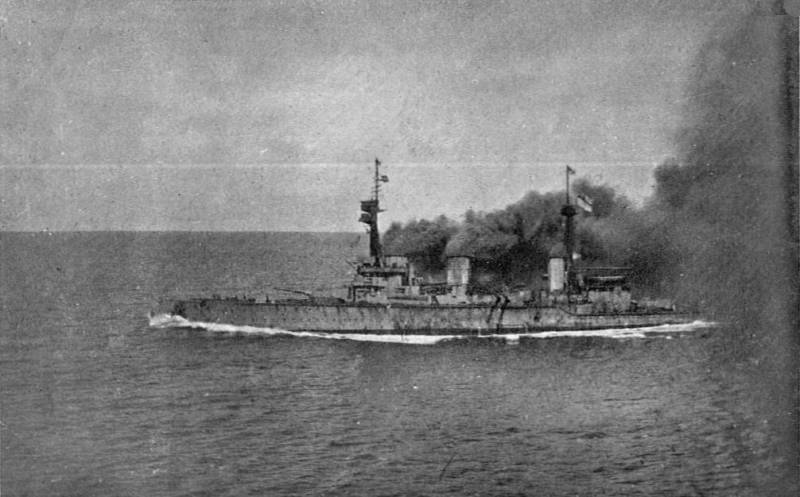
Information